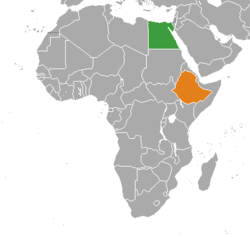Egypt–Ethiopia relations
 |
|
Egypt |
Ethiopia |
|---|---|
Egypt–Ethiopia relations refer to the bilateral relations between the governments of Egypt and Ethiopia. Both countries established diplomatic ties in 1927 to be the oldest on the African continent and one of the oldest in the world.[1] They are both members of the Nile Basin Initiative and share a relation of special nature due to their crucial roles in vital issues such as the Nile water file and the interest both share on establishing security in the Horn of Africa region by combating terrorism and piracy.[1]
History
The first contact between the two people dates back nearly seven thousand years ago when the ancient Egyptians launched their earliest recorded expedition to the Land of Punt under Sahure of the Fifth Dynasty although Punt gold dates back to even earlier times during the rule of King Khufu of the Fourth Dynasty. Ancient Egyptians called this place Ta-neter (The Gods' Land) and viewed it as a mysterious and unknown land of great fortune. They frequently engaged in trade expeditions with their partners in Punt where they acquired gold, incense, ebony, ivory, slaves, exotic animals and skins.[2]
Religious ties
Religion plays a crucial role in bringing the two countries closer as the Ethiopian Orthodox Tewahedo Church was under the administration of the Coptic Orthodox Church until 1959, when it was appointed its own Patriarch by the Coptic Orthodox Pope of Alexandria and Patriarch of All Africa, Cyril VI. Ethiopian Muslims are also closely attached to Al-Azhar in Cairo, where they have their own column to study under, named Al-Jabarta Column, under which numerous scholars studied such as Shaykh Abdurahman al-Jabarti.[3][4]
Economic ties
In 1905, the National Bank of Egypt helped establish Ethiopia's first ever bank, “The Bank of Abyssinia” which operated as an affiliate of the NBE, it received a 50-year monopoly and was the Ethiopian government’s fiscal agent as well as the sole issuer of notes and was responsible for collecting deposits and granting loans as well as trading in gold and silver, stockpiling staple commodities and investments.[3][5][6][7] In a sense, it operated as both a central and a commercial bank until 1930 when it was handed over to the Ethiopian government after Haile Selassie's ascension to the throne who could not accept that the country's issuing bank was foreign-owned. A new government-controlled bank, the Bank of Ethiopia, was installed in 1931 and kept management and almost all staff, premises and clients of the old bank until the Italian invasion in 1936 when it was liquidated.[7]
Today, there are over 72 Egyptian investments projects in Ethiopia in the fields of agriculture, livestock production, industry, tourism and real estate. Another project under implementation is an Egyptian industrial zone in the city of Adama, about 90 km from the capital Addis Ababa. Also, the Arab Contractors company opened an office in the country.[8] Below is statistical data showing the significant development of trade between the two countries between 2007 and 2009 in million US dollars of value:
| Statement/Year | 2007 | 2008 | 2009 |
|---|---|---|---|
| Egyptian exports to Ethiopia | 87.4 | 93.2 | 129.2 |
| Egyptian imports from Ethiopia | 7.5 | 13.4 | 16.9 |
| Volume of Trade | 94.9 | 106.6 | 146.1 |
| Trade Balance | 79.9 | 79.8 | 112.3 |
| Source: Ethiopian Customs Authority[8] | |||
Nile water file
In 1929, a British-sponsored treaty between Egypt and some Nile basin colonies awarded the former the right to veto any project that it deems threatening to its water share. Recently, however, Ethiopia announced the Grand Renaissance Dam project, which would allow it to better exploit its water resources, rejecting the old treaty and stressing that it wasn't a member back then. According to the Egyptian authorities, the dam, if built, would negatively affect Egypt's water share, estimated at 57 percent of the Nile waters.[9][10] Ethiopia turned down several requests from Egypt to pause the construction, furthering tensions between the two countries.[10]
References
Notes
- 1 2 "Egyptian-Ethiopian relations". State Information Service.
- ↑ Munro-Hay 2002, pp. 18
- 1 2 "Brief History of Egyptian-Ethiopian relations - Ministry of Foreign Affairs". Ministry of Foreign Affairs (Egypt).
- ↑ "African Christianity, Part One: A Short History (Egypt and Ethiopia)". Think About It, Know About It.
- ↑ G. Markus 2002, pp. 107
- ↑ Dr. Richard Pankhurst. "Early Ethiopian Banking History, 1 - The Bank of Abyssinia, and its Bank Notes". Link Ethiopia.
- 1 2 Arnaldo Mauri. "Origins and early development of banking in Ethiopia". Ideas.
- 1 2 "Economic Relations between Egypt and Ethiopia - Ministry of Foreign Affairs". Ministry of Foreign Affairs (Egypt).
- ↑ "Egypt and Ethiopia spar over the Nile".
- 1 2 "Ethiopia Rejects Egypt Proposal on Nile as Dam Talks Falter".
Bibliography
- Munro-Hay, Stuart (2002). Ethiopia, the Unknown Land: A Cultural and Historical Guide. London: I.B. Tauris. ISBN 9781860647444
- G. Markus, Harold (2002). A History of Ethiopia. Berkeley, California: University of California Press. ISBN 9780520224797
Further reading
- Foreign Ministry asks Ethiopia about Egyptians detained in Mubarak assassination attempt | Egypt Independent
- Egypt and Ethiopia vow to defuse Blue Nile dam row. BBC News.
- Nile Basin countries experts negotiation in Khartoum marked with disputes | Egypt Independent
- Ethiopia determined to construct Renaissance Dam: ambassador | Egypt Independent
- Ethiopian dam project to include Egypt and Sudan | Egypt Independent
- Minister: Diversion of Blue Nile no indication that Egypt approves of dam | Egypt Independent
- Foreign Ministry officials discuss Renaissance Dam crisis | Egypt Independent
- Qandil, acting pope to attend Zenawi’s funeral | Egypt Independent
- Qandil visits Ethiopia to offer condolences on Zenawi’s death | Egypt Independent
.svg.png)